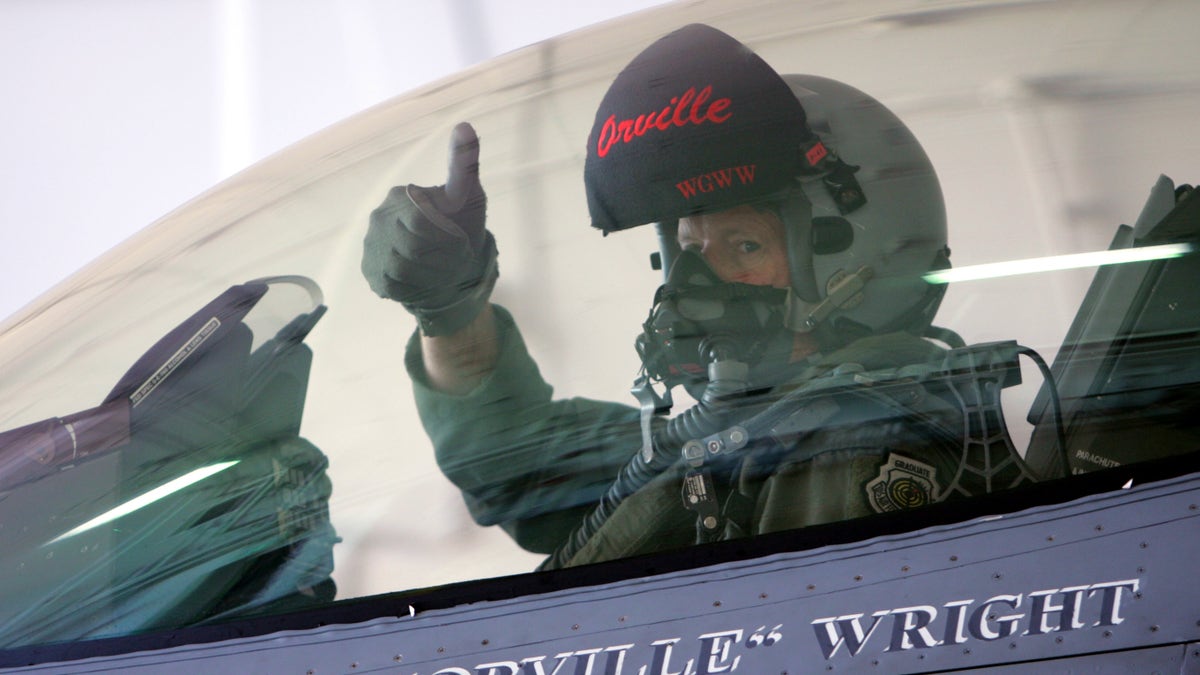
** ADVANCE FOR SUNDAY MAY 7 ** Lt. Gen. Bruce Wright flashes a thumbs-up signal from the cockpit of an F-16 fighter jet during a training at Misawa Air Base, northern Japan, Oct. 11, 2005. The F-16 Wild Weasel is primarily intended to locate and destroy surface-to-air missiles. (AP Photo/Itsuo Inouye) (AP Photo/Itsuo Inouye)
The job of a Wild Weasel is the most dangerous mission faced by today’s fighter pilots, a job more hazardous and difficult than shooting down enemy jets, according to retired Air Force Lt. Col. Dan Hampton in his book Viper Pilot: A Memoir of Air Combat.
These gutsy pilots are tasked with flying their specially outfitted fighter jets into enemy surface-to-air missile envelopes in order to bait SAM operators into targeting them with their radars. Once targeted, the radar waves are traced back to their source allowing the Wild Weasels and other attack aircraft to destroy the threat.
Actually, the unofficial motto of the Wild Weasel crews is YGBSM: “You Gotta Be Sh-tting Me.” It was B-52 Electronic Warfare Officer (EWO) veteran Jack Donovan’s natural response when he was introduced to the tactics and mission details. His exact reply was: “you want me to fly in the back of a little tiny fighter aircraft with a crazy fighter pilot who thinks he’s invincible, home in on a SAM site in North Vietnam, and shoot it before it shoots me, you gotta be sh-tting me!” His vernacular stuck and YGBSM is prominently displayed on the patch of some squadrons, adding to the legend of the Wild Weasel.
The Wild Weasel radar detection and suppression concept was developed by the Air Force during the Vietnam War to combat the growing surface-to-air (SAM) threat, specifically the Soviet-made SA-2 Goa. It’s the same type of missile that brought down the CIA U-2 spy plane over Russia piloted by Francis Gary Powers on May 1, 1960. Powers was arrested by the Soviets after he was shot down and eventually released to the U.S., he’s the subject of Tom Hank’s 2015 film, Bridge of Spies.
Birth of the Wild Weasel
During the Vietnam War, the Weasels used two tactics to accomplish their mission. The first tactic, dubbed “Hunter Killer,” used Wild Weasels to hunt down enemy air defense systems and F-105 Thuds to kill them.
The tactic was developed from on-the-job training, for lack of a better description. It was the best play they had against the SA-2. All the U.S. military knew about the SA-2 was that they were usually camouflaged, had a range of 15 to 20 miles and used a target tracking radar. The latter was key for the Weasels because they used it to home in on the target with radar-seeking missiles while the F-105s flew in with heavier ordnance and cluster munitions to complete the kill.
“We knew that we could survive at low-level, use terrain masking, pop up to get their readings and attack the sight,” said a former Weasel pilot in the video below.
The second tactic was to protect the strike force during regular missions. The Weasels would provide themselves as decoys to encourage SAM launches that generated enough smoke to make them visible — like a smoking gun. Meanwhile, the strikers zeroed in on their targets. The Weasels would orbit the target area for 20 to 40 minutes exposed to enemy fighters, SAMs, and air artillery shells (AAA).
Both tactics were very dangerous and resulted in a high fatality rate. After about seven weeks of operations, the first Wild Weasels only had one aircraft left, and many members of the original 16 aircrews had been killed in action, were POWs or had left the program, wrote Warren E. Thompson for HistoryNet.
More from WeAreTheMighty.com:
These veterans made a gun safety device that unlocks with a fingerprint
6 rare facts about the Battle of the Bulge
These 18 photos show the bravery of US troops during the Battle of the Bulge

